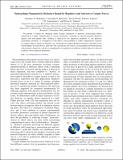| dc.contributor.author | Rodriguez, Alejandro W. | |
| dc.contributor.author | McCauley, Alexander Patrick | |
| dc.contributor.author | Woolf, David | |
| dc.contributor.author | Capasso, Federico | |
| dc.contributor.author | Joannopoulos, John D. | |
| dc.contributor.author | Johnson, Steven G. | |
| dc.date.accessioned | 2010-09-28T15:32:19Z | |
| dc.date.available | 2010-09-28T15:32:19Z | |
| dc.date.issued | 2010-04 | |
| dc.date.submitted | 2009-12 | |
| dc.identifier.issn | 0031-9007 | |
| dc.identifier.uri | http://hdl.handle.net/1721.1/58733 | |
| dc.description.abstract | We present a scheme for obtaining stable Casimir suspension of dielectric nontouching objects immersed in a fluid, validated here in various geometries consisting of ethanol-separated dielectric spheres and semi-infinite slabs. Stability is induced by the dispersion properties of real dielectric (monolithic) materials. A consequence of this effect is the possibility of stable configurations (clusters) of compact objects, which we illustrate via a molecular two-sphere dicluster geometry consisting of two bound spheres levitated above a gold slab. Our calculations also reveal a strong interplay between material and geometric dispersion, and this is exemplified by the qualitatively different stability behavior observed in planar versus spherical geometries. | en_US |
| dc.description.sponsorship | United States. Army Research Office. Institute for Soldier Nanotechnologies (Contract No. W911NF-07-D-0004) | en_US |
| dc.description.sponsorship | United States. Dept. of Energy (Grant No. DE-FG02-97ER25308) | en_US |
| dc.description.sponsorship | United States. Defense Advanced Research Projects Agency (Contract No. N66001-09-1-2070-DOD) | en_US |
| dc.language.iso | en_US | |
| dc.publisher | American Physical Society | en_US |
| dc.relation.isversionof | http://dx.doi.org/10.1103/PhysRevLett.104.160402 | en_US |
| dc.rights | Article is made available in accordance with the publisher's policy and may be subject to US copyright law. Please refer to the publisher's site for terms of use. | en_US |
| dc.source | APS | en_US |
| dc.title | Nontouching Nanoparticle Diclusters Bound by Repulsive and Attractive Casimir Forces | en_US |
| dc.type | Article | en_US |
| dc.identifier.citation | Rodriquez, Alejandro W. et al. "Nontouching Nanoparticle Diclusters Bound by Repulsive and Attractive Casimir Forces." Physical Review Letters 104.16 (2010): 160402. © 2010 The American Physical Society | en_US |
| dc.contributor.department | Massachusetts Institute of Technology. Department of Mathematics | en_US |
| dc.contributor.department | Massachusetts Institute of Technology. Department of Physics | en_US |
| dc.contributor.approver | Johnson, Steven G. | |
| dc.contributor.mitauthor | Rodriguez, Alejandro W. | |
| dc.contributor.mitauthor | McCauley, Alexander Patrick | |
| dc.contributor.mitauthor | Joannopoulos, John D. | |
| dc.contributor.mitauthor | Johnson, Steven G. | |
| dc.relation.journal | Physical Review Letters | en_US |
| dc.eprint.version | Final published version | en_US |
| dc.type.uri | http://purl.org/eprint/type/JournalArticle | en_US |
| eprint.status | http://purl.org/eprint/status/PeerReviewed | en_US |
| dspace.orderedauthors | Rodriguez, Alejandro W.; McCauley, Alexander P.; Woolf, David; Capasso, Federico; Joannopoulos, J. D.; Johnson, Steven G. | en |
| dc.identifier.orcid | https://orcid.org/0000-0001-7327-4967 | |
| dc.identifier.orcid | https://orcid.org/0000-0002-7244-3682 | |
| mit.license | PUBLISHER_POLICY | en_US |
| mit.metadata.status | Complete | |
